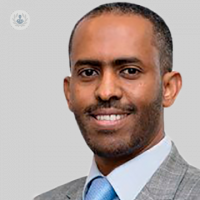Sciatica unraveled: Causes, symptoms, and solutions
Written in association with:Sciatica, characterised by pain radiating from the lower back down to the leg, is a common condition often stemming from a slipped or prolapsed disc pressing on the sciatic nerve. In his latest online article, Mr Ahmed Ibrahim explores the main causes of sciatica, typical symptoms experienced by patients, and various treatment approaches available.

What are the main causes of sciatica?
The most common cause of sciatica is a slipped or prolapsed disc, also known as a herniated disc. These terms refer to the same condition, where a nerve forming part of the sciatic nerve is under pressure, leading to pain that starts in the back and radiates down the leg to a specific point, depending on which nerve is affected. In essence, sciatica results from pressure on a nerve, typically due to a disc issue, causing leg pain.
What symptoms do patients usually experience?
Typically, individuals with a slipped disc initially experience back pain. This onset is often sudden, followed by the pain gradually radiating down the leg, which may occur within a day or a few days. For some, the back pain diminishes while the leg pain becomes more prominent. This scenario is a common presentation of sciatica. However, variations exist; for instance, some may feel pain in the calf first, skipping the thigh, before experiencing discomfort in the buttock. Despite these differences, the classical presentation involves initial back pain followed by pain in the right or left leg, depending on which side is affected by compression.
Is treatment always necessary or can sciatica resolve itself?
Fortunately, sciatica tends to improve on its own for the most part, despite the initial severity of pain, which can reach a high level on the pain scale. It's understandable that patients find it challenging to accept this, especially when the pain is intense at the onset. However, it's crucial to remember that sciatica typically shows gradual improvement in 70 to 80% of individuals within a few weeks. Painkillers or ant neuropathic medications may be necessary initially to manage the discomfort. If these methods prove ineffective, injections can be considered as a temporary solution to alleviate pain, allowing for physiotherapy and further recovery.
Unfortunately, in about 20% or fewer cases, the pain persists beyond six weeks despite these interventions. In such instances, surgical intervention may be recommended. Surgical options range from minimally invasive procedures to traditional open surgery, with the former being preferred for most patients due to its less invasive nature and minimal impact on the structural integrity of the spine.
How is sciatica is treated?
We believe that there are several treatment approaches for sciatica. In some cases, a watch-and-wait approach is sufficient if the symptoms and pain are not severe. Other options include physiotherapy, followed by injections. These injections typically involve local anaesthetic and may be administered around the affected nerve to provide relief. Surgery, in the form of microdiscectomy, is considered as a final option if other treatments fail to alleviate the condition.
Can lifestyle modifications help to relieve sciatica pain?
During the acute phase of pain, it's advisable to avoid prolonged sitting. Opting for a dining chair over a sofa can be beneficial. Contrary to common belief, staying active and engaging in regular exercise can help alleviate pain rather than resting for extended periods. For individuals who spend most of their day seated at a desk, using a standing desk, if available, can provide relief by allowing them to alternate between sitting and standing positions. Basic physiotherapy exercises, which can be found online or provided by a physiotherapist, such as pelvic tilting and other manoeuvres, can help alleviate discomfort by opening up space in the affected area. It's also advisable to address any work-related issues related to prolonged sitting early on, if possible, to aid in the management of symptoms for most patients.
Mr Ahmed Ibrahim is an esteemed neurosurgeon. You can schedule an appointment with Mr Ibrahim on his Top Doctors profile.


